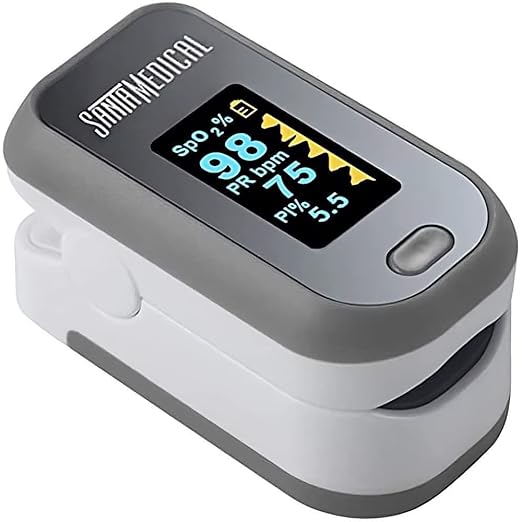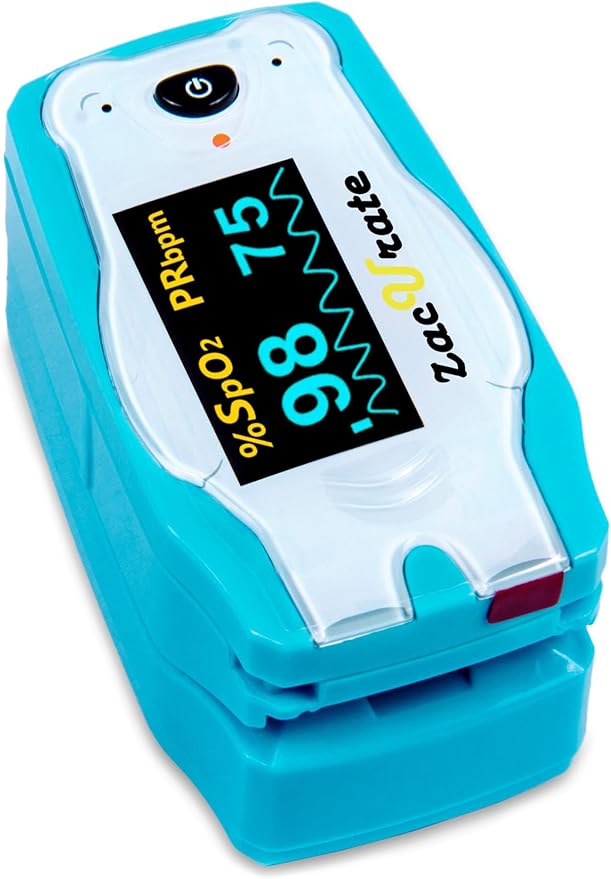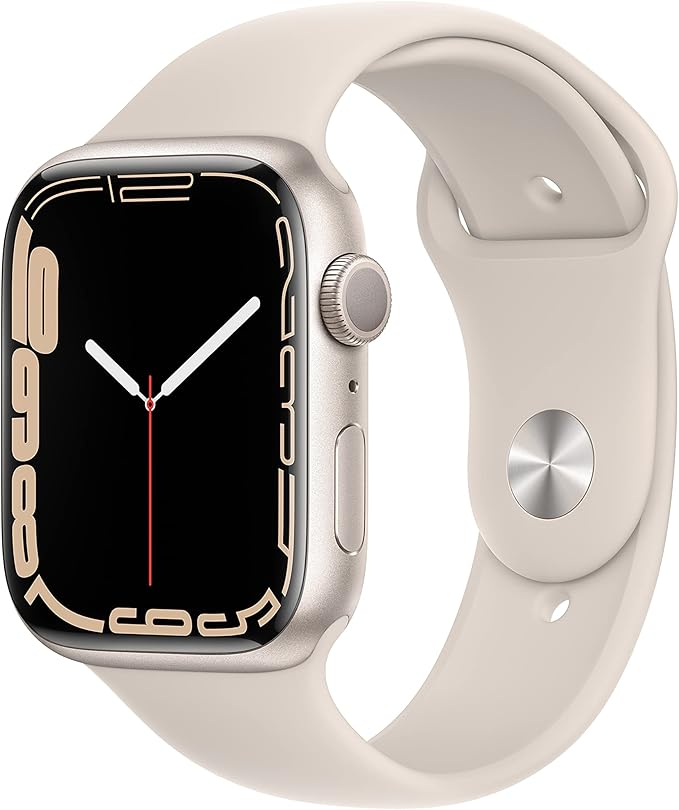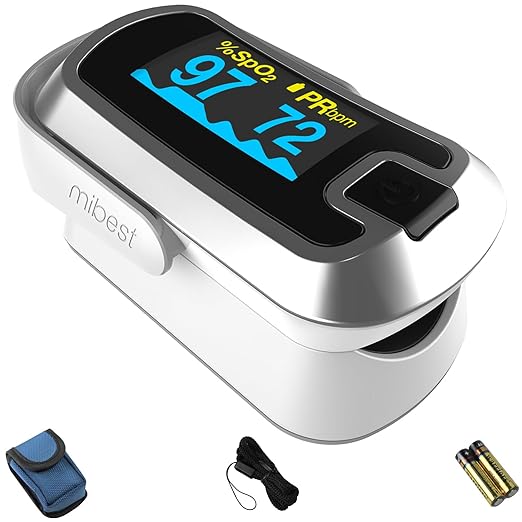Best Pulse Oximeters 2025
Looking for the Best Pulse Oximeters that can truly simplify monitoring your health? We know worrying about low oxygen levels can feel overwhelming, so we’ve gathered top-rated oxygen monitors that deliver fast, accurate readings directly when you need them most. Our expert guide offers powerful tips to boost your peace of mind and safeguard your well-being. Dive in now to discover how these reliable devices can transform your health routine!
Contents
- Top 5 Pulse Oximeters
- 1. SantaMedical Finger Pulse Oximeter – Best Pulse Oximeter Overall
- 2. Zacurate Children Digital – Best Child-Size Version Pulse Oximeter
- 3. Apple Watch Series 7 – Best Smart Watch with Pulse Oximeter
- 4. Accare Fingertip Pulse Oximeter – Best Large Display Pulse Oximeter
- 5. mibest OLED Finger Pulse Oximeter – Best Budget Pulse Oximeter
- Things To Consider When Buying a Pulse Oximeter:
- Understanding Pulse Oximeters
- Types of Pulse Oximeters
- Pros and Cons of Each Type
- Key Factors to Consider
- Accuracy and Calibration
- Display Features
- Tips for Selecting the Right Pulse Oximeter
- User-Friendliness
- Budget Considerations
- Step-by-Step Buying Guide
- Researching Brands and Models
- Reading Customer Reviews
- Maintenance and Care
- Cleaning Your Pulse Oximeter
- Battery and Usage Tips
- Frequently Asked Questions
- Common Concerns
- Troubleshooting Issues
- Conclusion
Top 5 Pulse Oximeters
1. SantaMedical Finger Pulse Oximeter – Best Pulse Oximeter Overall

Lightweight and no fuss, the SantaMedical Finger Pulse Oximeter ticks all the boxes when ranking health monitors. You’ll love its excellent performance, which continues to exceed in comparison to other models in its class for its reliability. Quick and accurate readings make you comfortable to track your oxygen levels and pulse rate.
You’re going to love is the finger chamber that can fit both kids and adults. This is ideal therefore for families and can be used comfortably by everyone. What’s more, the real-time Puse Rate and SpO2 measurement keeps a bright during high-strength training! This exceeds expectations, whether you’re skinning, biking or flying at elevations deep into the zone of oxygen depletion, and for both the #sportie and flyboy.
Packed with accessories, it comes with 2 AAA batteries and a neck/wrist cord to add convenience/portability. You also won’t have to make a deal with a store owner to get you some batteries in a hurry. It’s easy and convenient to take it with you where ever you go with the included cord. And, the intuitive display makes it easy to read information at a glance.
Only minor drawback is they only come in a few colors. Still, this is a minor flaw and you won’t even notice it if you’re going to use the S300 for better performance and ease. SantaMedical’s Finger Pulse Oximeter, Tested SantaMedical’s Finger Pulse Oximeter is a reliable, compact device that no household should be without.
This pulse oximeter is the perfect one for people who are looking for an accurate and easy to use option. Find out why it’s an essential tool for keeping tabs on your health.
2. Zacurate Children Digital – Best Child-Size Version Pulse Oximeter

Adorable but also practical, the Zacurate Children Digital pulse oximeter is an ideal pick for your kids. This unit has a cute cartoon Polar bear appearance, and is particularly suitable for children aged 2-12.
Just press the bear’s nose to turn it on, and within seven seconds, you’ll have received SpO2 and Pulse Rate readings. Its playful design inspires children to participate in the process, so they do not focus so much on the stress of checking their stats. All of which are important when making an interpretation of what is seen on the display.
Small enough for little fingers, it’s snug enough to be accurate. It might be a bit awkward to use with adult fingers, but no biggie. It displays read-outs that align well with less hi-tech models when put to the test on one’s little ones, so its accuracy can be trusted.
What’s most striking is how kid-friendly it is. Promoting healthy habits has never been more fun. Easy to store or take along, suitable for travel, or visiting doctor’ s.
One minor downside is that it is sensitive to finger size — adults might have trouble getting readings. But that only emphasizes its child-centered design.
If you need to keep an eye on your child’s oxygen levels, and do it easily and enjoyably, the Zacurate Kids Digital is a winner all-round. Find out why families are calling this pulse oximeter an “awesome little device”!
3. Apple Watch Series 7 – Best Smart Watch with Pulse Oximeter

Look no farther for the best smart watch with a pulse oximeter}() Apple Watch Series 7 features a swimproof design and IPX6 dust resistance. For those who care about health tracking, this watch is absolutely loaded with advanced features.
You can also take ECG and perform full day motion tracking. Sleep app features that utilize motion sensors to monitor your sleep activity allow you to do just that: know your rest. You can even time how long you wash your hands — a bit of Health app monitoring that is just what the doctor ordered these says.
An impressive feature is the array of 4 IR LEDs sensing low SpO2 within just 15 seconds. It’s never been easier to keep this close eye on your blood oxygen during the day. The watch also provides you with VO2 Max data available in multiple apps. You will get alerted if your levels fall, providing some peace of mind.
The larger watch face is very user-friendly, I don’t have to struggle to read my notifications or monitor my metrics. By far, the Series 7 sets itself apart from similar products by how it manages the access and the user interface, both great improvements.
But the battery life could be better for some users. And don’t forget to charge it on a regular basis, especially if you’re a heavy user of features that tend to drain a battery.
What makes the Apple Watch Series 7 such a winner is how it combines utility with aesthetics. You’re going to love how it gets into your daily life, and keeps you connected and informed. Find out more about this amazing smart watch here today!
4. Accare Fingertip Pulse Oximeter – Best Large Display Pulse Oximeter

Enter the Accare Fingertip Pulse Oximeter. Its big, bright screen is much better than other models’. Clarity is important, and this oximeter is even great under low light conditions. Read your blood oxygen level and pulse rate immediately without squinting.
The installation is pleasingly easy. Clip it to your finger and see it spring into action. There is nothing complicated about it, spelling good news for users of all ages. It has clear classification for blood pressure and blood oxygen, which ensures that we can read it clearly and use it easily.
This device is portable and can be carried around with you where ever you go with its convenient lanyard. When folded out, you can take it in your bag or wear on your neck, great for monitoring on external and while travelling. The instant readings also mean it is a life saver during high cord days and you need an immediate check.
The most impressive aspect is the turn-around time. Figures come nearly as soon as you drop an image in, giving you what you need to concentrate on.
A few users report it doesn’t open quite as wide as other brands. This minor issue would only concern people with big fingers. But it hardly matters, because the the bright readouts are going to be what you notice first.
The Accare Fingertip Pulse Oximeter is a big, bold device that offers an easy user experience in a competitive field. It’s perfect for anyone who wants simplicity without compromising on performance.
5. mibest OLED Finger Pulse Oximeter – Best Budget Pulse Oximeter

The mibest OLED Finger Pulse Oximeter is the best cheap pulse oximeter we’ve been able to find. Nothing can beat its excellent quality and unbeatable price, which is why it’s on the top of the list for a lot of people.
Ease of set up impresses at the outset. “Just put the batteries in and you are ready to go. People love how the LED display is clear and reads quickly and how it alleviates the stress some other health devices can create. Its comfortable, secure fit works with a wide range of finger sizes; anyone in your household can wield it with ease.
Others may find the sensitivity of this device a little much to handle. Correct finger position is critical for accurate readings. It does but you have to have a little patience with the proper positioning, but once mastered you get very reliable results. You will get used to it and the accuracy of data becomes intuitive.
One highlight is that it’s focused on precision. It does, however, take careful positioning at the outset, but once you have this, these are solid readings. You want a tool that only gives you the information you truly need, and this is that tool.
The mibest pulse oximeter stands out in terms of its clear display and overall ease of use. It almost costs nothing and gives great value to the user and everyone could afford keeping track of their health now.
Though it’s a bitchy thing to learn about the perfect finger fit, it’s a fucking godsend when you master it. Get the benefits and see why this oximeter is becoming so popular. Check it out and up your health tracking game!
Things To Consider When Buying a Pulse Oximeter:
Pulse oximeters are crucial devices that allow you to monitor your oxygen saturation levels and heart rate, providing valuable insights into your respiratory health. When purchasing a pulse oximeter, you should consider factors such as accuracy, ease of use, display type, and additional features that suit your lifestyle. Whether for personal or medical use, understanding these elements will help you make an informed decision and ensure you choose the best device for your needs.
Understanding Pulse Oximeters
Your journey into the world of pulse oximeters begins with understanding this imperative device. A pulse oximeter measures the oxygen saturation level of your blood and can help monitor your health, especially for individuals with respiratory conditions. This small, non-invasive device provides quick readings, allowing you to keep an eye on your oxygen levels from the comfort of your home or while on the go.
Types of Pulse Oximeters
Your choice of pulse oximeter can greatly affect its usability and accuracy. There are various types available for different needs:
- Finger Pulse Oximeters
- Handheld Pulse Oximeters
- Wrist-Worn Pulse Oximeters
- Portable Pulse Oximeters
- Hospital-Grade Pulse Oximeters
Knowing the specific features and functions of each type can help you make an informed decision.
Pros and Cons of Each Type
Pulse oximeters come with their own set of advantages and disadvantages. Understanding these can guide your purchasing decision:
| Pros | Cons |
| High accuracy for medical purposes | Can be more expensive |
| Portable options for convenience | Some models may have slower response times |
| Non-invasive operation | Battery life varies between models |
| Easy to use and read | Limited to fingertip use in some designs |
| Continuous monitoring available | May not work effectively with low blood flow |
Cons of each type may vary based on specific models and features. Some pulse oximeters can be more suited for medical environments, while others may prioritize portability and ease of use. By assessing the pros and cons of various models, you can find a pulse oximeter that best fits your requirements.
Key Factors to Consider
Clearly, when buying a pulse oximeter, there are several key factors to consider to ensure you choose the right device for your needs:
- Accuracy and Calibration
- Display Features
- Portability
- Battery Life
- Price and Warranty
After weighing these factors, you will be better equipped to make an informed decision.
Accuracy and Calibration
For a pulse oximeter, accuracy is fundamental. You will want to choose a model that provides precise oxygen saturation readings. Look for devices that are FDA-approved, as these typically adhere to strict accuracy standards. Additionally, check if the device requires periodic calibration to maintain optimal performance.
Display Features
Features of the display can significantly impact your user experience. A clear, bright screen with easy-to-read digits will enhance your ability to quickly assess your oxygen saturation levels, especially in dim lighting conditions. Some models may also include additional features like trend graphs or multi-directional viewing.
Accuracy in display features is vital for effective monitoring. A good pulse oximeter should present data in real-time, allowing you to understand fluctuations in your blood oxygen levels. The clarity of the display can aid you in quickly making health decisions based on the readings, especially during emergencies. Look for features like adjustable brightness and the ability to view data from different angles, as these enhance usability.
Tips for Selecting the Right Pulse Oximeter
You want to choose the right pulse oximeter to ensure accurate readings and ease of use. Consider the following features:
- Display size and readability
- Battery life and power source
- Finger placement comfort
- Accuracy ratings and certifications
- Ease of cleaning and maintenance
After evaluating these factors, you’ll be well-equipped to choose the best option for your needs.
User-Friendliness
Assuming you’ll be using the device frequently, opt for a model that offers straightforward operation. Look for features like one-button design and easy-to-read displays to make checking your oxygen levels hassle-free. Intuitive interfaces can greatly enhance your experience, allowing you to focus on monitoring your health without unnecessary complications.
Budget Considerations
For selecting a pulse oximeter, your budget is an crucial factor. Prices can range significantly based on the features and brand.
It’s important to balance cost and functionality. While budget-friendly options may seem appealing, investing a little more in a reliable device can offer greater accuracy and longevity. Look for reputable brands that provide warranties and customer support, ensuring that you get the best value for your money without sacrificing quality or performance.
Step-by-Step Buying Guide
Many factors come into play when purchasing a pulse oximeter, and following a structured approach can make the decision easier. Begin by assessing your specific needs, then consider the following elements:
Researching Brands and Models
Brands that have a solid reputation often provide quality products. Research various manufacturers and read up on their offerings to ensure you choose a reliable model that fits your expectations.
Reading Customer Reviews
Assuming that customer feedback is necessary, you should deeply analyze reviews from actual users. These insights can guide you toward the best options available on the market.
Customer reviews often provide honest opinions about real-life experiences with the pulse oximeter. They can highlight both the strengths and weaknesses of models you are considering, enabling you to make an informed choice based on diverse perspectives and user satisfaction ratings.
Maintenance and Care
Keep your pulse oximeter in top condition by performing regular maintenance and care. This includes cleaning it properly and ensuring you follow proper usage guidelines to extend its lifespan and accuracy.
Cleaning Your Pulse Oximeter
With regular use, your pulse oximeter can accumulate dirt and oils. To maintain its effectiveness, wipe the device with a soft, lint-free cloth and a mild disinfectant solution occasionally, ensuring you avoid any harsh chemicals that could damage the device.
Battery and Usage Tips
While using your pulse oximeter, it’s vital to mind its battery life and usage. Here are some tips to optimize performance:
- Store the device in a cool, dry place.
- Turn it off when not in use to conserve battery.
- Replace the batteries as recommended by the manufacturer.
Any time you notice a decrease in performance, check the battery level and replace it if necessary.
It is also advisable to follow these additional battery tips for better longevity:
- Avoid exposing the device to extreme temperatures.
- Do not mix old and new batteries when replacing.
- Regularly check for firmware updates to enhance performance.
Any maintenance oversight may impact accuracy and usage efficiency.
Frequently Asked Questions
To help you make an informed decision, it’s vital to address common inquiries regarding pulse oximeters. Many users wonder about their accuracy, suitable features, and the importance of brands. Understanding these aspects can significantly enhance your selection process and ensure you choose the right device for your needs.
Common Concerns
Frequently, users express concerns about the accuracy of pulse oximeters under various conditions, such as nail polish, skin tone, or motion during usage. It’s important to choose a reliable model and read reviews to alleviate these worries. Additionally, consider checking the manufacturer’s specifications to ensure the device meets your expectations.
Troubleshooting Issues
To troubleshoot common issues with your pulse oximeter, first ensure that it is placed correctly on your finger, with adequate blood circulation. Check batteries if the display is not functioning, and confirm that the device is clean and free from obstructions. Understanding these factors can help you maintain accuracy and reliability.
Another helpful tip is to periodically recalibrate your pulse oximeter according to the manufacturer’s instructions. If you encounter persistent inaccuracies despite proper usage, consider contacting customer support for assistance. They can provide specific guidance or suggestions that pertain to your device, ensuring you achieve the best performance from your pulse oximeter.
Conclusion
The key considerations when buying a pulse oximeter involve ensuring its accuracy, choosing the appropriate design for your needs, and verifying its ease of use. Look for FDA approval or clinical validation to enhance reliability. Consider features such as display readability and data tracking options that align with your health monitoring goals. Additionally, assess battery life and maintenance requirements to ensure a seamless user experience. By evaluating these factors, you can make an informed decision that supports your health management effectively.